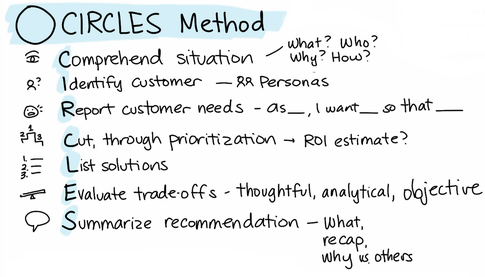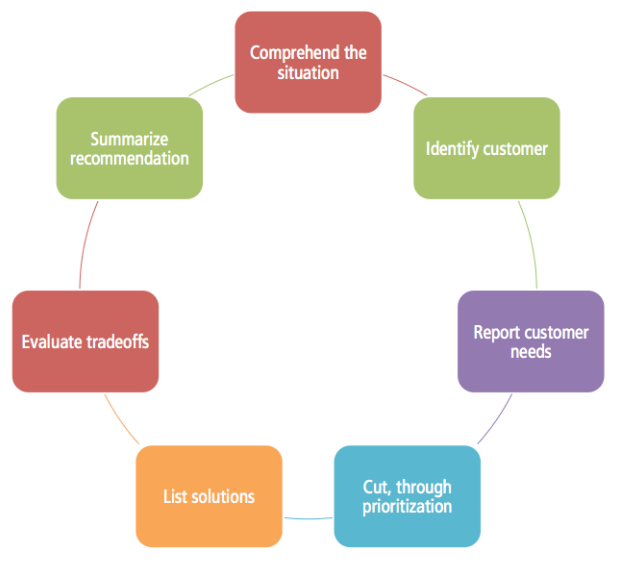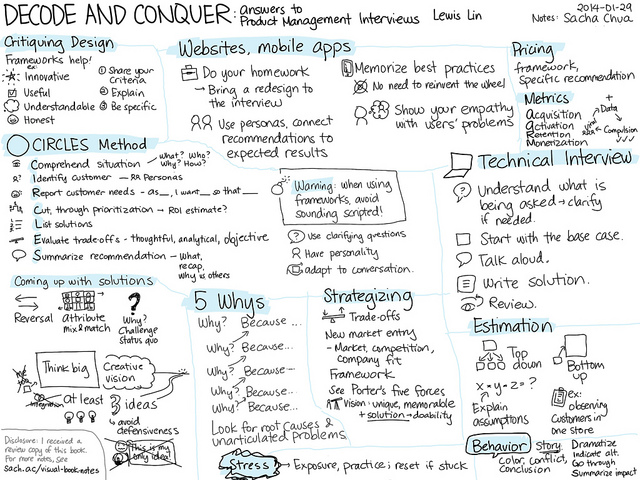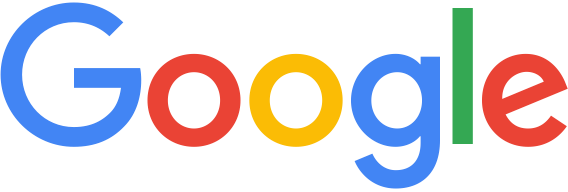I just released a new book, The Product Manager Interview. It’s my 2nd product management interview book after my Amazon bestseller, Decode and Conquer.
You may be curious: what is the CIRCLES Method™ product design framework? To help demystify, I’ve explained it below, using excerpts from Decode and Conquer.
Introduction to CIRCLES Method™ Product Design Framework

What are product design questions?
Product design questions test your product design ability. Interviewers are assessing your ability to:
- Define an objective for the product improvement
- Choose and identify the most appropriate target customer
- Empathize with the target customer
- Articulate use cases (aka pain points)
- Prioritize those use cases
- Brainstorm creative ideas
- Make a logical recommendation
Examples of product design questions include:
-
- Redesign the Facebook Newsfeed for the Web.
-
- How would you improve Pinterest?
-
- Create an experience around Disney theme parks using your phone.
-
- Design the next product that Nest will offer, focusing on mobile app design.
- If you were the CEO of LEGO, what new product line would you come up with to increase revenues? Why? Who is the target customer? How do you reach them? How does the product function and what does it look like (UI/UX)? What’s the potential market size?
Note: Many of the above questions are featured in The Product Manager Interview with an accompanying sample answer.
What are interviewers looking for?
The interviewers are looking for six key elements in a strong response:
-
- Goals and metrics. Did the candidate define objectives before answering? Were the candidate’s selections reasonable?
-
- Target Persona & Pain Points. Did the candidate choose a target persona? Did the candidate explain the persona’s pain points to the extent that demonstrated true consumer insight?
-
- Prioritization. Did the candidate demonstrate ability to prioritize competing use cases or pain points in a compelling way?
-
- Creativity. Did the candidate demonstrate sufficient creativity? Or were the ideas copycats of competitive features and products?
-
- Development Leadership. When asked, did the candidate have a reasonable explanation of how a proposed feature would be implemented?
- Summary and Next Steps. Did the candidate summarize their main argument at the end, including clear next steps?
What is the CIRCLES Method™?

CIRCLES Method™ is a framework on what makes a complete, thoughtful response to any design question. It’s a memory aid that prevents us from forgetting a step in the interview. You can also think of it as a checklist or guideline.
Use it for questions on how you would design a new desktop, website, or mobile application. You can even use it to design new consumer products like a car, camera or can opener.
In case you forget, remember that designers love circles. Therefore the CIRCLES Method™ is perfect for design questions.
Comprehend the Situation
Not too long ago, I asked a candidate, “Pretend you are a Windows 10 product manager. How would you improve it?” I stopped her 45 seconds into her response. She rambled and used nonsense phrases like “Windows 10 deepens customer empowerment.”
I asked her, “Have you used Windows 10?” She sheepishly replied, “Never. I use a MacBook Air.”
Sigh. If you don’t know the product, speak up. It’s not fair for you to discuss a product you don’t know.
You’re entitled to ask the interviewer clarifying questions. What can or should you ask the interviewer?
Here’s a list:
- What is it?
- Who is it for?
- Why do they need it?
- When is it available?
- Where is it available?
- How does it work?
This list of basic questions is frequently called the “5 W’s and H.” However, the interviewer may not have patience for you to ask 101 questions about the product. To start the interview, you really just need answers for the four bolded questions: what is it, who is it for, why do they need it, and how does it work? So we’ll call our version the “3 W’s and H.”
If the interviewer refuses to answer your clarifying questions, make an assumption based on what you know. Then, give the interviewer an opportunity to correct you, in the event he thinks differently about whom it is for or how the product works.
I also recommend that you pull up the website, mobile app or application. A visual improves communication. And who knows, since we live in the world of rapid experimentation, the website that you saw yesterday may have changed today. Or if you’re talking about a product that the interviewer is working on, it’s possible they use a beta version internally, which is completely different from what you use. It would be lethal if you and the interviewer were thinking of different things.
Identify the Customer
There’s no magical device that does everything for everyone. But that hasn’t stopped companies from trying to build all-in-one devices. As sexy as they sound, all-in-ones aren’t very good.
During the interview, you want to propose an amazing product, not a mediocre one. To do so, focus and empathize with a single customer segment or persona. By putting yourself in the customer’s shoes, you will more likely design a solution that resolves their specific needs.
Start the second step of the CIRCLES Method™ by listing potential customer personas. Here are some examples:
- Food lovers
- Soccer moms
- College students
- Small business owners
Time is limited, so choose one persona to focus on. The interviewer may not be familiar with your chosen persona; help them comprehend whom you are talking about. A 2 x 2 matrix is a powerful way to visualize it.
| Kat, the traveling reader |
Behaviors
- Goes on vacations with books
- Travels four times a year
- Carries four books per trip
|
Demographics
- 55 year old, single female
- Lives in Hoquiam, Washington
- Income: $70,000 USD
|
Needs & Goals
- Discover new books
- Discuss books with others
- Write a book one day
|
Report the Customer’s Needs
The third step of the CIRCLES Method™ is reporting the customer’s needs. You can call it user needs, user requirements, or use cases. In modern product development, the use case format is a popular way to capture user needs. A user story conveys what the end user wants to do in normal everyday language. It does not describe how the solution works. Here’s the user story template:
As a <role>, I want <goal/desire> so that <benefit>.
Here are two examples based on our persona, Kat, our traveling reader:
Book discovery
As a traveling reader, I want to get recommendations so that I read books that are either well-written or are good examples of my favorite genres.
Write a book
As a traveling reader, I want to write 500 words a day so that I can publish my memoir.
User stories have become popular because they are concise, complete and casual. In a single sentence, we know the user, the user’s needs and the intended benefit.
It’s important to explore customer needs deeply, especially if there are hidden needs or constraints. Why? Here’s a classic anecdote from one of my students:
During her product management interview with a top 5 technology company, she was asked to, “Design the perfect airport.” She plunged into the exercise, detailing what the airport of the future would look like, including numerous runways to eliminate delays and a sprawling food court that would satisfy any palate.
As she concluded her answer, the interviewer revealed that the airport would have to fit into 100 square feet.
Needless to say, she did not get the job. But it reinforces the power digging deeper and asking the simple yet powerful question, “Why?”
Cut, Through Prioritization
Looking at our “book discovery” and “write a book” use cases above, each one screams for completely different solutions. Step four of the CIRCLES Method™ is to cut, through prioritization.
The prioritization step mimics the real world development process. You’ll have a big backlog of use cases, but you’re limited by time, money, and labor. Which one do you do first?
In the interview, you don’t have time to discuss all use cases. So you’ll have to pick one. When you make your choice, it’s an opportunity to showcase your ability to make prioritize, assess tradeoffs and make decisions.
| User Story |
Revenue |
Customer Satisfaction |
Ease of Implementation |
Overall |
| Write a book |
A |
A |
A |
A |
| Book discovery |
C |
C |
C |
C |
The prioritization matrix example above shows how a product manager can be thoughtful about choosing priorities.
Real world prioritization is not that different from the matrix above. That is, it’s based on subjective criteria, weights and grades. Despite some flaws, I feel the matrix is effective. I’d rather have an imperfect process than no process at all. The matrix method forces the decision maker to think and articulate what’s important. Is revenue more important? Or is customer satisfaction? Ultimately, the true arbiter of go versus no-go for a particular feature should be A/B testing.
If you’re looking for an even more thoughtful and quantitative approach to prioritization, you could estimate the revenue impact and investment, measured in engineering effort. From there, you can calculate a ROI-like metric, which I call revenue per point of effort.
| User Story |
Revenue impact |
Story size |
Revenue per point of effort |
Priority |
| Write a book |
$500,000 |
8 |
$62,500 |
1 |
| Book discovery |
$20,000 |
2 |
$10,000 |
2 |
Note: “Story size” is a metric to estimate the engineering effort necessary to complete a story.
List Solutions
Step five of the CIRCLES Method™ is to list solutions. For instance, if we wanted a solution to help consumers to reduce their junk mail, we could offer the following solutions:
- Global do not mail list. Consumers can sign-up for the mailing list, and responsible companies can periodically check the list and opt-out consumers.
- Opt out Camera App. Create a mobile app that allows consumers to opt-out of junk mail by taking a picture of the junk mail they receive.
- SMS Opt Out. Allow consumers to opt out of junk mail by texting a special code to a SMS number.
- Third Party Review. Send all your mail to a third-party who will review your mail, discard your junk mail and forward the rest.
- Junk Mail Warning Application. Before you submit your personal information to a website, a sweepstakes, or a product warranty registration site, this application will warn you on whether or not you’re likely to receive junk mail when sharing your personal information to the site.
Most candidates freeze when they have a design problem without a solution on the tip of their tongue. Brainstorming frameworks can help overcome designer’s block. Here are my favorites:
Reversal method. Reversing the situation helps uncover new possibilities.
Example: Create a new car buying experience.
Need: Buyers don’t have time to travel to the car dealership.
Solution based on reversal: Dealership should deliver test drives to the buyer’s home.
Attribute method. List all the product attributes. Mix and match to get interesting new combinations.
Example: Design a new laundry hamper.
| Material |
Shape |
Finish |
Position |
| Wicker |
Square |
Natural |
Sits on floor |
| Plastic |
Cylindrical |
Painted |
On ceiling |
| Paper |
Rectangle |
Clear |
On wall |
| Metal |
Hexagonal |
Luminous |
Basement chute |
| Net material |
Cube |
Neon |
On door |
Solution based on attributes: I suggest we build a rectangle, plastic hamper with a natural finish that can be mounted on the door.
Why? Method. Challenge the status quo.
Example: Design a new coffee cup.
Start by challenging the status quo: Why should coffee cups have handles? Cups are too hot to hold directly.
Solution based on Why? Method: Create a coffee mug with an insulation layer.
I have two more tips when listing potential product solutions.
Tip #1: Think big
Your typical candidate usually list solutions that fall into one of two categories:
- Me too ideas. For example, “As the Google+ product manager, I would create a new feature that’s similar to Facebook’s groups feature.” Yawn.
- Integration ideas. For instance, “As the Google product manager, I would integrate YouTube with Android.” Yawn.
As part of the interview, most employers are evaluating your creativity or product vision. They’re looking for product managers that can see future trends, both in technology and customer behavior. They expect those product managers to plot and execute a plan that exploits that trend, for the company’s benefit.
To help spur your thinking, consider the following big bets from the tech industry leaders:
- In 2008, Google made a $4.6 billion bid for wireless spectrum. How did Google have the gravitas to make a multi-billion dollar bid when Google had no experience as a wireless operator? Google had guts. In the end, it was one of the biggest bluffs in business history. Google didn’t win the bid, but they didn’t want to. They got the FCC to adopt open access rules that would force the winner to allow any Google device or application to connect to this new spectrum. That privilege was worth billions to Google. And they got it for free.
- That same year, Facebook launched Facebook Connect. Facebook encouraged developers to use Facebook as their sign-in service. Facebook positioned the feature as trustworthy and easy-to-use. Developers could now devote time that would have gone into building proprietary sign-up and sign-on systems for something else. And web and mobile applications would have access to a user’s valuable Facebook data. But Facebook had the biggest win. Facebook Connect allowed Facebook to track user behavior around the web. They knew which websites a user visited and what mobile apps they used. They could use this data to build better products, and more importantly, deliver more targeted ads. Facebook makes billions from advertising. Better ad targeting can easily lead to a 500 percent increase in revenue.
Tip #2: Have at least three ideas
Great innovators know that your first idea is rarely the best. Why? Innovation is an iterative process. As you learn more about customer needs and competitive products, your proposed solutions will be more precise and focused. You’ll avoid ideas that have failed in the marketplace.
At the interview, brainstorm at least three ideas. It’s hard but it’ll be worth it. You’ll find that idea number 2 or 3 will usually be the best of the bunch.
Also, it will help you from being defensive during the interview. The interviewer will critique your idea. If you have only one idea, you’ll take it personally. If you have multiple ideas, you’ll be more comfortable because you’ll have other solutions to prove your self-worth.
Evaluate Tradeoffs
The sixth step of the CIRCLES Method™ is to evaluate tradeoffs. The first part is optional: define your tradeoff criteria. Criteria could include customer satisfaction, implementation difficulty, and revenue potential. It’s not necessary, but it’ll keep your response organized and easier to follow.
The next part is analyzing the solution. A pro and cons list is a good way to do this.
By evaluating tradeoffs of each solution, you come across as thoughtful and analytical. You’ll also be perceived as objective.
You’ll also protect yourself from being defensive. If you’ve taken the initiative to critique your own solutions, the interviewer has fewer things to criticize. You’ll also mentally prepare yourself for criticism by critiquing yourself.
Summarize Your Recommendation
The seventh step of the CIRCLES Method™ is to summarize your recommendation. This is an optional step; sometimes the interviewer is satisfied with a brainstorm and the pro and con analysis.
But others want to test your communication and decision making skills. That is, can you present a short 20 to 30 second summary of your product proposal? And can you make the hard decision to suggest just one solution?
Summarize with this three-step approach:
- Tell the interviewer which product or feature you’d recommend.
- Recap on what it is and why it’s beneficial to the user and/or company.
- Explain why you preferred this solution vs. others.
Tip on using the CIRCLES Method™
My clients often struggle with design questions because they’re uncomfortable exploring customers and needs without a solution. If that’s the case, it’s okay to have a solution in mind and lead your CIRCLES Method™ discussion toward it.
It’s important for you to exude confidence during the design discussion, and if this is what makes you feel better, fantastic. I also find that having a solution in mind can help constrain the realm of potential personas, needs, and solutions, which can improve the quality of your responses.
Ultimately, I would love for you to embrace the great unknown and enjoy a design problem without having a solution in mind.




